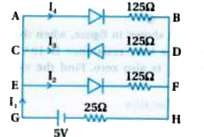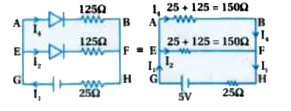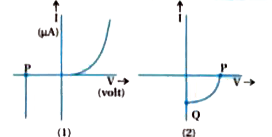
If each diode in figure has a forward bias resistance of 25Ω and infinite resistance in reverse bias, what will be the values of the current I1,I2,I3andI4? Solution in Gujrati
In above figure, diode in branch CD is reverse biased. Hence its resistance is ∞ and so current passing through it is I3=0 and so it can be removed from given network.

In figure (2) I1=I2+I4 (1)
Here resistance in branches AB and EF are same and so:
I2=I4=I12 ....(2)
Applying Kirchhoff.s second law along closed path GEFHG,
−150I2−25I1=−5
∴150I2+25I1=5
∴150I2+25(2I2)=5
∴200I2=5
∴I2=0.025A
∴I4=0.025A (∵I2=I4)
From equation (1),
I1=I2+I4
∴I1=0.025+0.025=0.05A
Topper's Solved these Questions
- SEMICONDUCTOR ELECTRONICS : MATERIALS, DEVICES AND SIMPLE CIRCUITS BOOK - KUMAR PRAKASHANCHAPTER - SEMICONDUCTOR ELECTRONICS : MATERIALS, DEVICES AND SIMPLE CIRCUITS EXERCISE - Section-D : Multiple Choice Questions (MCQs) (MCQs From .DARPAN. Based On Textbook)
116 Videos
- SEMICONDUCTOR ELECTRONICS : MATERIALS, DEVICES AND SIMPLE CIRCUITS BOOK - KUMAR PRAKASHANCHAPTER - SEMICONDUCTOR ELECTRONICS : MATERIALS, DEVICES AND SIMPLE CIRCUITS EXERCISE - Section-D : Multiple Choice Questions (MCQs) (MCQs asked in Competitive Exams)
129 Videos
- SEMICONDUCTOR ELECTRONICS : MATERIALS, DEVICES AND SIMPLE CIRCUITS BOOK - KUMAR PRAKASHANCHAPTER - SEMICONDUCTOR ELECTRONICS : MATERIALS, DEVICES AND SIMPLE CIRCUITS EXERCISE - Section-C: NCERT Exemplar Solution (Short Answer Type Questions)
8 Videos
- SAMPLE QUESTION PAPER BOOK - KUMAR PRAKASHANCHAPTER - SAMPLE QUESTION PAPER EXERCISE - PART-B SECTION-C
5 Videos
- WAVE OPTICSBOOK - KUMAR PRAKASHANCHAPTER - WAVE OPTICSEXERCISE - SECTION-D (MULTIPLCE CHOICE QUESTIONS (MCQS)) (MCQS FROM DARPAN BASED ON TEXTBOOK)
239 Videos
Similar Questions
Which of the following is not a conductor of electricity?
View SolutionAt absolute zero temperature Si acts as ……..
View Solution
(i) Name the type of a diode whose characteristics are shown in figure (1) and figure (2).
(ii) What does the point P in figure (1) represent?
(iii) What does the points P and Q in figure (2) represent?
View SolutionTwo charges –q and +q are located at points (0, 0, –a) and (0, 0, a), respectively.
(a) What is the electrostatic potential at the points (0, 0, z) and (x, y, 0) ?
(b) Obtain the dependence of potential on the distance r of a point from the origin when r/a>>1 .
(c) How much work is done in moving a small test charge from the point (5,0,0) to (–7,0,0) along the x-axis? Does the answer change if the path of the test charge between the same points is not along the x-axis?
View SolutionAccording to particle theory of light what is the velocity of light in a dense medium, compared to that in rare medium ?
View SolutionIf each diode in figure has a forward has a forward bias resistance of 25 Omega and infinite resistance in reverse bias, what will be the values of the current I_1 , I_2 , I_3 and I_4?
View SolutionWhy is a photodide operated in reverse bias mode? Fig. shown reverse bias current, under different illuminating intensities I_(1)I_(2),I_(3) and I_(4) for a given photodiode. Average the intensities I_(1), I_(2),I_(3) and I_(4) in decreasing order of wavelength.
View SolutionIn a p−n junction diode, the currect I can expressed as I=I0exp(eV2kBT−1) where I0 is called the reverse saturation current, V is the voltage across the diode and is positive for forward bias and negative for reverse bias, and I is the current through the diode, KB is the Boltzmann constant (8.6×10−5eV/K) and T is the absolute temperature. If for a given diode Io=5×10−12A and T=300K, then
(a) What will be the forward current at a formward voltage of 0.6V ?
(b) What will be the increase in the current if the voltage across the diode is increased to 0.7V ?
( c) What is the dynamic resistance ?
(d) What will be current if reverse bias voltage changes from 1V to 2V ?
View SolutionIn a p−n junction diode, the currect I can expressed as I=I0exp(eV2kBT−1) where I0 is called the reverse saturation current, V is the voltage across the diode and is positive for forward bias and negative for reverse bias, and I is the current through the diode, KB is the Boltzmann constant (8.6×10−5eV/K) and T is the absolute temperature. If for a given diode Io=5×10−12A and T=300K, then
(a) What will be the forward current at a formward voltage of 0.6V ?
(b) What will be the increase in the current if the voltage across the diode is increased to 0.7V ?
( c) What is the dynamic resistance ?
(d) What will be current if reverse bias voltage changes from 1V to 2V ?
View SolutionFind relation in between current i_(1), i_(2), i_(3), i_(4), i_(5)" and "i_(6) .
View Solutionनिम्न चित्र में परिपथ का तुल्य - प्रतिरोध एव i1 तथा i2 धाराओं के मान ज्ञात कीजिए । बैटरी की निर्गत शक्ति (power output ) क्या है ?

View SolutionCalculate the values of currents · I_(1)I_(2)I_(3) and I_(4) Is and loin the section of networks shown in the figure
View SolutionA photodiode is operated in reverse mode under different illumination intensities I1I2I3 and I4 if I1<I2<I3<I4 show reverse bias current for different intensities on a current voltage graph take reverse bias voltage to be same
View SolutionAssume that each diode shown has a forward bias resistance of 50Ω and an infinite reverse bias resistance. The current through the resistance 150Ω is

View SolutionIf each diode in figure has a forward bias resistance of 25 Omega and infinite resistance in reverse bias, what will be the values of the current I_1 , I_2 , I_3 and I_4?
View Solution
